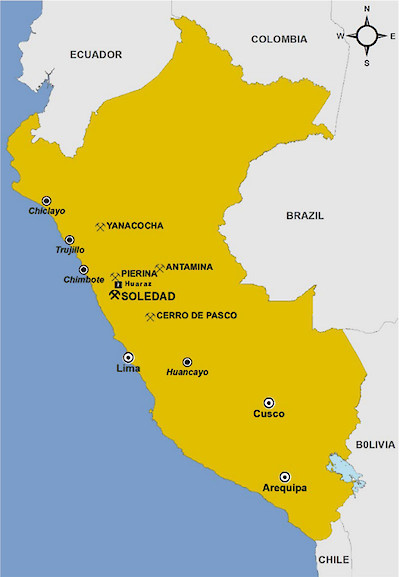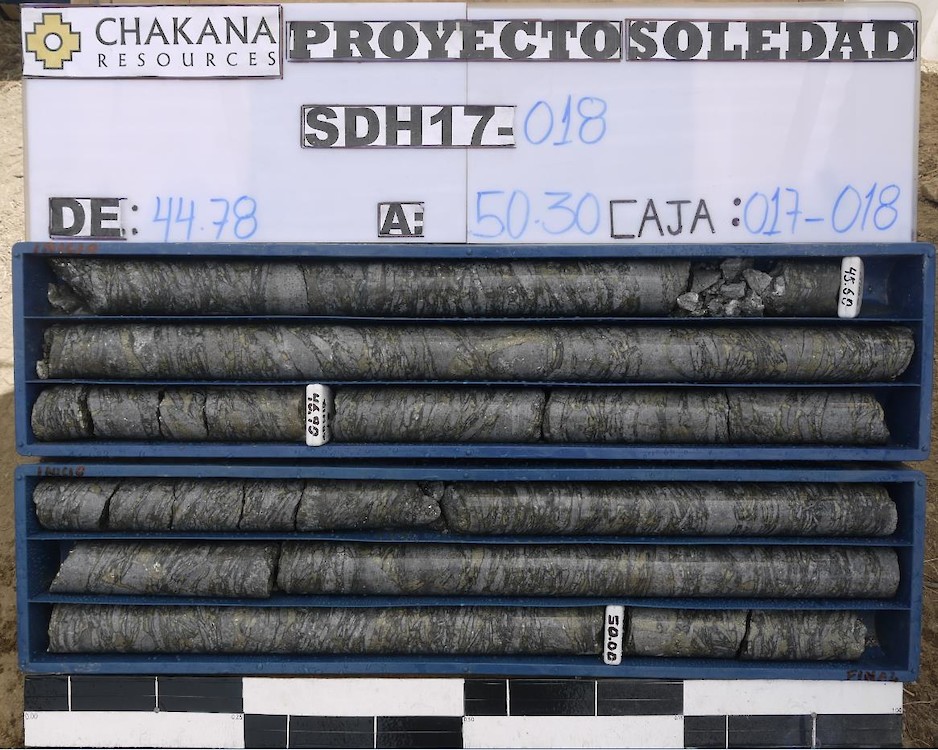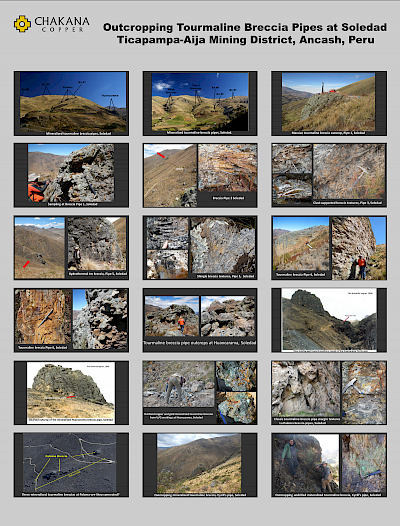The Soledad project was acquired in February, 2017 under a 100% purchase option agreement with Condor Resources.

Fig. 1 - Location of Soledad project in Central Peru
The Soledad project is located in Ancash province of central Peru, approximately 260 km north-northwest of Lima and 35 km south of Barrick’s Pierina mine (Fig. 1). The project is part of the Ticapampa-Aija Mining District in the Cordillera Negra, a region with a long history of exploration and mining.
Previous exploration identified numerous high grade quartz-tourmaline-sulfide breccia pipes that crop out at surface. Whereas the mineralization hosted in the breccia pipes is impressive in terms of grade and vertical extent, previous explorers were focused on a blind mineralized porphyry target inferred to be the source of the breccia mineralization. Chakana is focused on testing the breccia pipes to determine if they host economic mineralization.
The breccia pipes are principally hosted in the Calipuy group volcanic rocks, consisting of andesite flows, tuff and rhyolite with a composite thickness of over 2,000m. A secondary host is granodiorite that intrudes the volcanic rocks. A 16,000m drill program was initiated August 16, 2016, designed to determine the geometry of several previously drilled pipes, determine the true grade profile by drilling across the pipes, define an initial inferred resource on 2 of the pipes, and test a number of targets across the property.
Drilling to-date has focused on Breccia Pipe #1 and #5. Previous drilling on Bx #1 confirmed a vertical extent of mineralized breccia from surface to 490m depth where the drill hole deviated out of the breccia pipe. Based on previous IP surveys and a recent CS/NS-AMT survey, the pipes are thought to extend much deeper. Highlights from the first five holes completed in Bx #1 by Chakana are as follows:
|
DDH # |
From - To (m) |
Core |
Au |
Ag |
Cu |
Zn |
Pb |
Cu-eq |
Au-eq |
|
|---|---|---|---|---|---|---|---|---|---|---|
|
SDH17-022 |
0.0 |
21.0 |
21.0 |
4.87 |
32.9 |
|
|
|
|
5.30 |
|
and |
43.0 |
76.0 |
33.0 |
5.31 |
66.1 |
0.39 |
|
|
4.43 |
6.77 |
|
including |
65.0 |
76.0 |
11.0 |
4.03 |
160.8 |
0.95 |
|
|
4.96 |
7.59 |
|
and |
99 |
107.0 |
8.0 |
1.13 |
35.0 |
1.83 |
|
|
2.87 |
4.39 |
|
SDH17-023 |
0.0 |
36.0 |
36.0 |
2.39 |
8.8 |
|
|
|
|
2.51 |
|
including |
19.0 |
23.0 |
4.0 |
3.62 |
35.7 |
1.84 |
|
|
4.51 |
6.90 |
|
and |
119.0 |
127.4 |
8.4 |
9.73 |
128.0 |
0.12 |
0.67 |
1.24 |
7.58 |
11.59 |
|
SDH17-024 |
0 |
69.0 |
69.0 |
3.15 |
11.3 |
0.39 |
|
|
2.55 |
3.89 |
|
including |
47.0 |
69.0 |
22.0 |
3.89 |
21.3 |
1.18 |
|
|
3.91 |
5.97 |
|
and |
73.0 |
84.0 |
11.0 |
0.98 |
2.82 |
|
|
|
|
1.02 |
|
SDH17-025 |
0.0 |
30.0 |
30.0 |
3.50 |
8.0 |
|
|
|
|
3.60 |
|
and |
48.0 |
53.0 |
5.0 |
10.05 |
22.1 |
0.74 |
|
|
7.50 |
11.47 |
|
and |
131.0 |
144.0 |
13.0 |
3.57 |
892.5 |
2.41 |
1.09 |
0.58 |
12.37 |
18.93 |
|
SDH17-026 |
0 |
5.0 |
5.0 |
3.85 |
23.9 |
|
|
|
|
4.16 |
The pipes form a cluster within 4 km2 and are spaced between 176m to 625m apart with vertical relief between the pipes of over 500m. The breccia is polymictic and contain clasts reflecting the adjacent host rock, either andesite or granodiorite. Clasts of andesite are generally tabular in shape, forming “shingle” texture, and are strongly altered to quartz-sericite-tourmaline. Grades are typically highest on the margins of the breccia bodies where permeability was best developed. Contacts with the wall rock are sharp, and there is a well-defined halo away from the contact characterized by sheeted quartz-sericite-sulfide veining with decreasing intensity within 3m of the contact. Mineralization is hosted within the matrix of the breccia and as clast replacement and consists of sulfide and sulfosalt minerals. Based on initial petrography, the sulfide assemblage includes chalcopyrite, hypogene chalcocite, digenite, pyrite, tetrahedrite, boulangerite, bournonite, and arsenopyrite. Sphalerite and galena are common on the margin of the breccia or within veinlets in the fractured host andesite. Gold occurs as free blebs in the 20-100 um size range within pyrite.
Tourmaline breccia pipes can have diameters that increase at depth, and typically have an oval shape reflecting structural control. Drilling is designed to test this from surface to 400m depth based on: 1) drilling from a central platform at various azimuths and dip angles to penetrate the margin of the breccia throughout its vertical extent; and 2) from platforms outside the pipe to drill across the breccia body. Mineralized intercepts will vary in length due to the shape of the breccia body and the orientation of the drill hole (see Figure 2 or whichever figure reference, please us updated figure attached). For example, shallow holes drilled near the perimeter of the pipe may have shorter intercepts compared to steeper holes. Nonetheless, all holes that intersect mineralized breccia are important for constraining the overall shape and grade of the breccia body. Once a sufficient number of intercepts are obtained and modelled, the overall geometry of the breccia body and the grade profile will become apparent.
|
DDH # |
From - To (m) |
Core |
Au |
Ag |
Cu |
Zn |
Pb |
Cu-eq |
Au-eq |
|
|---|---|---|---|---|---|---|---|---|---|---|
|
SDH17-027 |
0.0 |
12.0 |
12.0 |
3.54 |
78.1 |
|
|
|
|
4.56 |
|
and |
133.4 |
143.0 |
9.6 |
1.60 |
6.0 |
0.29 |
|
|
1.39 |
2.12 |
|
and |
161.0 |
168.0 |
7.0 |
0.81 |
49.4 |
1.93 |
0.76 |
0.36 |
2.88 |
4.41 |
|
SDH17-028 |
0.0 |
14.0 |
14.0 |
4.48 |
27.3 |
|
|
|
|
4.84 |
|
and |
204.25 |
231.4 |
27.15 |
0.76 |
74.0 |
2.51 |
|
|
3.64 |
5.57 |
|
SDH17-029 |
0.0 |
14.4 |
14.4 |
5.84 |
38.0 |
|
|
|
|
6.34 |
|
and |
94.9 |
121.0 |
26.1 |
0.63 |
226.6 |
3.69 |
0.84 |
0.76 |
6.04 |
9.24 |
|
and |
133.0 |
145.0 |
12.0 |
0.17 |
8.5 |
0.69 |
|
|
0.87 |
1.34 |
|
and |
203.0 |
222.0 |
19.0 |
2.01 |
32.4 |
1.97 |
|
|
3.56 |
5.45 |
|
SDH17-030 |
0.0 |
14.0 |
14.0 |
3.29 |
68.6 |
|
|
|
|
4.19 |
|
and |
98.0 |
118.0 |
20.0 |
0.71 |
18.1 |
0.44 |
|
|
1.06 |
1.62 |
|
SDH17-031 |
0.0 |
135.0 |
135.0 |
1.02 |
35.2 |
0.60 |
|
|
1.57 |
2.40 |
|
including |
0.0 |
59.0 |
59.0 |
1.15 |
12.1 |
|
|
|
|
1.31 |
|
including |
59.0 |
135.0 |
76.0 |
0.93 |
53.1 |
1.04 |
|
|
2.10 |
3.22 |
|
SDH17-032 |
0.0 |
28.0 |
28.0 |
3.39 |
13.0 |
|
|
|
|
3.56 |

Core from SDH17-031 for 105.9 to 111.3m showing strong copper mineralization in the matrix of the tourmaline breccia.


